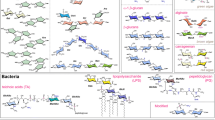Abstract
Solution-state nuclear magnetic resonance (NMR) spectroscopy can be used to monitor protein–carbohydrate interactions. Two-dimensional 1H-15N heteronuclear single quantum coherence (HSQC)-based techniques described in this chapter can be used quickly and effectively to screen a set of possible carbohydrate-binding partners, to quantify the dissociation constant (Kd) of any identified interactions, and to the map the carbohydrate-binding site on the structure of a protein. Here, we describe the titration of a family 32 carbohydrate-binding module from Clostridium perfringens (CpCBM32) with the monosaccharide N-acetylgalactosamine (GalNAc), in which we calculate the apparent dissociation of the interaction and map the GalNAc binding site onto the structure of CpCBM32. This approach can be applied to other CBM– and protein–ligand systems.
Access this chapter
Tax calculation will be finalised at checkout
Purchases are for personal use only
Similar content being viewed by others
References
Cala O, Guilliere F, Krimm I (2014) NMR-based analysis of protein-ligand interactions. Anal Bioanal Chem 406:943–956
Haselhorst T, Lamerz AC, Itzstein M (2009) Saturation transfer difference NMR spectroscopy as a technique to investigate protein-carbohydrate interactions in solution. Methods Mol Biol 534:375–386
Johnson MA, Pinto BM (2004) NMR spectroscopic and molecular modeling studies of protein-carbohydrate and protein-peptide interactions. Carbohydr Res 339:907–928
Nieto PM (2018) The use of NMR to study transient carbohydrate-protein interactions. Front Mol Biosci 5:1–7
Zuiderweg ER (2002) Mapping protein-protein interactions in solution by NMR spectroscopy. Biochemistry 41:1–7
Kay LE, Keifer P, Saarinen T (1992) Pure absorption gradient enhanced. J Am Chem Soc 114:10663–10665
Lian LY, Barsukov IL, Sutcliffe MJ, Sze KH, Roberts GC (1994) Protein-ligand interactions: exchange processes and determination of ligand conformation and protein-ligand contacts. Methods Enzymol 239:657–700
Johnson BA (2018) From raw data to protein backbone chemical shifts using NMRFx processing and NMRViewJ analysis. Methods Mol Biol 1688:257–310
Vranken WF, Boucher W, Stevens TJ, Fogh RH, Pajon A, Llinas M, Ulrich EL, Markley JL, Ionides J, Laue ED (2005) The CCPN data model for NMR spectroscopy: development of a software pipeline. Proteins 59:687–696
Skinner SP, Fogh RH, Boucher W, Ragan TJ, Mureddu LG, Vuister GW (2016) CcpNmr AnalysisAssign: a flexible platform for integrated NMR analysis. J Biomol NMR 66:111–124
Grondin JM, Chitayat S, Ficko-Blean E, Houliston S, Arrowsmith CH, Boraston AB, Smith SP (2014) An unusual mode of galactose recognition by a family 32 carbohydrate-binding module. J Mol Biol 426:869–880
Grondin JM, Duan D, Kirlin AC, Abe KT, Chitayat S, Spencer HL, Spencer C, Campigotto A, Houliston S, Arrowsmith CH, Allingham JS, Boraston AB, Smith SP (2017) Diverse modes of galacto-specific carbohydrate recognition by a family 31 glycoside hydrolase from Clostridium perfringens. PLoS One 12:e0171606
Kitaoku Y, Fukamizo T, Numata T, Ohnuma T (2017) Chitin oligosaccharide binding to the lysin motif of a novel type of chitinase from the multicellular green alga, Volvox carteri. Plant Mol Biol 93:97–108
Koay A, Rimmer KA, Mertens HD, Gooley PR, Stapleton D (2007) Oligosaccharide recognition and binding to the carbohydrate binding module of AMP-activated protein kinase. FEBS Lett 581:5055–5059
Ohnuma T, Onaga S, Murata K, Taira T, Katoh E (2008) LysM domains from Pteris ryukyuensis chitinase-A: a stability study and characterization of the chitin-binding site. J Biol Chem 283:5178–5187
Viegas A, Sardinha J, Freire F, Duarte DF, Carvalho AL, Fontes CM, Romao MJ, Macedo AL, Cabrita EJ (2013) Solution structure, dynamics and binding studies of a family 11 carbohydrate-binding module from Clostridium thermocellum (CtCBM11). Biochem J 451:289–300
Boraston AB, Bolam DN, Gilbert HJ, Davies GJ (2004) Carbohydrate-binding modules: fine-tuning polysaccharide recognition. Biochem J 382:769–781
Boraston AB, Ficko-Blean E, Healey M (2007) Carbohydrate recognition by a large sialidase toxin from Clostridium perfringens. Biochemistry 46:11352–11360
Ficko-Blean E, Boraston AB (2006) The interaction of a carbohydrate-binding module from a Clostridium perfringens N-acetyl-beta-hexosaminidase with its carbohydrate receptor. J Biol Chem 281:37748–37757
Ficko-Blean E, Boraston AB (2009) N-acetylglucosamine recognition by a family 32 carbohydrate-binding module from Clostridium perfringens NagH. J Mol Biol 390:208–220
Ficko-Blean E, Stuart CP, Suits MD, Cid M, Tessier M, Woods RJ, Boraston AB (2012) Carbohydrate recognition by an architecturally complex alpha-N-acetylglucosaminidase from Clostridium perfringens. PLoS One 7:e33524
Wilkins MR, Gasteiger E, Bairoch A, Sanchez JC, Williams KL, Appel RD, Hochstrasser DF (1999) Protein identification and analysis tools in the ExPASy server. Methods Mol Biol 112:531–552
Delaglio F, Grzesiek S, Vuister GW, Zhu G, Pfeifer J, Bax A (1995) NMRPipe: a multidimensional spectral processing system based on UNIX pipes. J Biomol NMR 6:277–293
Author information
Authors and Affiliations
Corresponding author
Editor information
Editors and Affiliations
Rights and permissions
Copyright information
© 2023 The Author(s), under exclusive license to Springer Science+Business Media, LLC, part of Springer Nature
About this protocol
Cite this protocol
Grondin, J.M., Langelaan, D.N., Smith, S.P. (2023). Qualitative and Quantitative Characterization of Protein–Carbohydrate Interactions by NMR Spectroscopy. In: Abbott, D.W., Zandberg, W.F. (eds) Carbohydrate-Protein Interactions. Methods in Molecular Biology, vol 2657. Humana, New York, NY. https://doi.org/10.1007/978-1-0716-3151-5_8
Download citation
DOI: https://doi.org/10.1007/978-1-0716-3151-5_8
Published:
Publisher Name: Humana, New York, NY
Print ISBN: 978-1-0716-3150-8
Online ISBN: 978-1-0716-3151-5
eBook Packages: Springer Protocols




